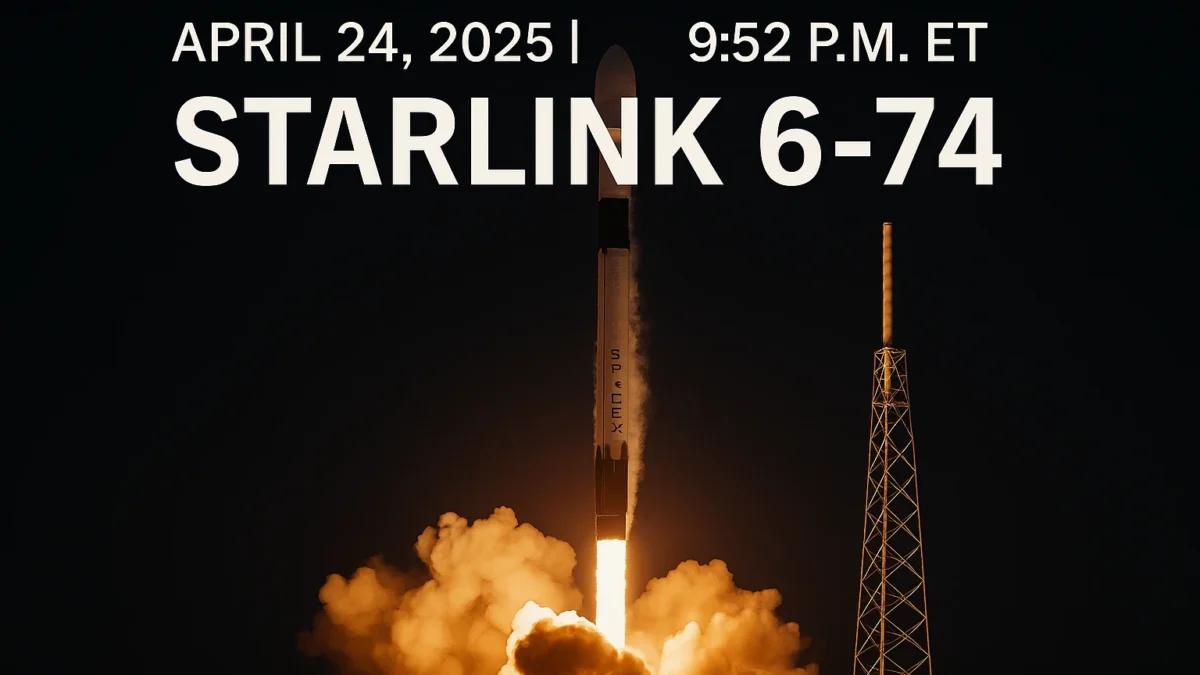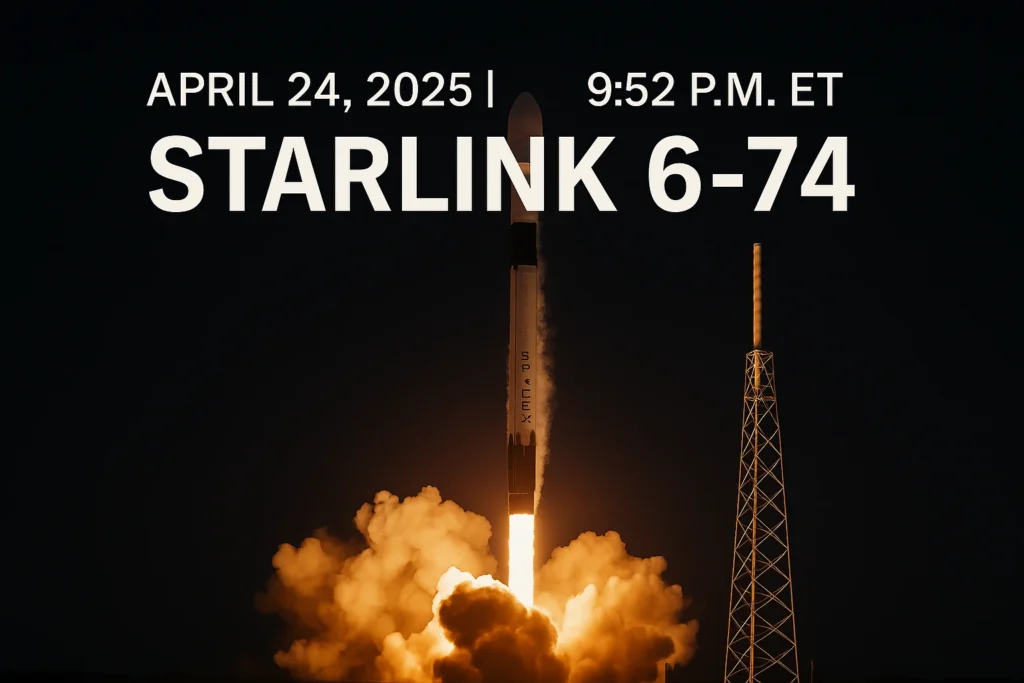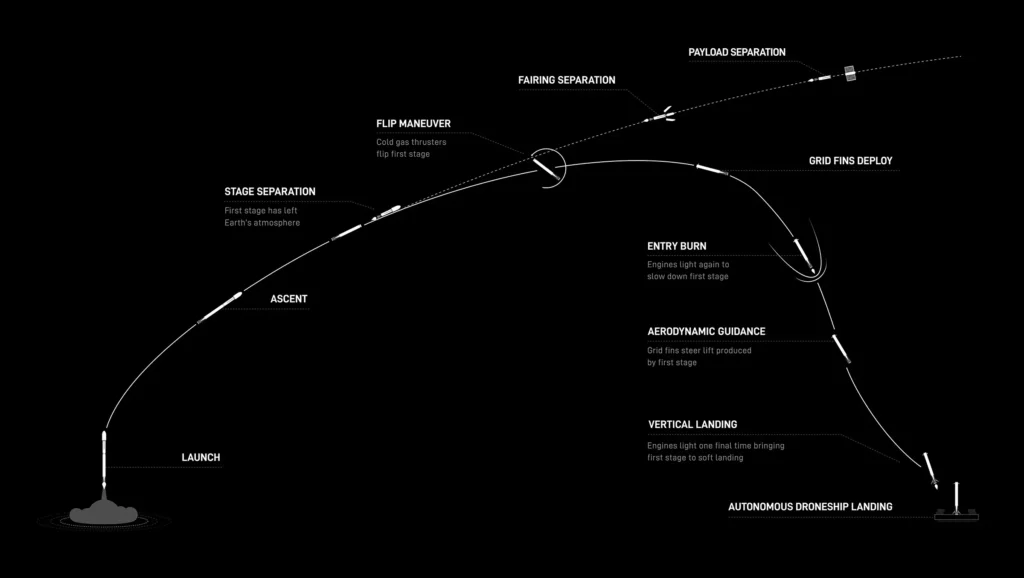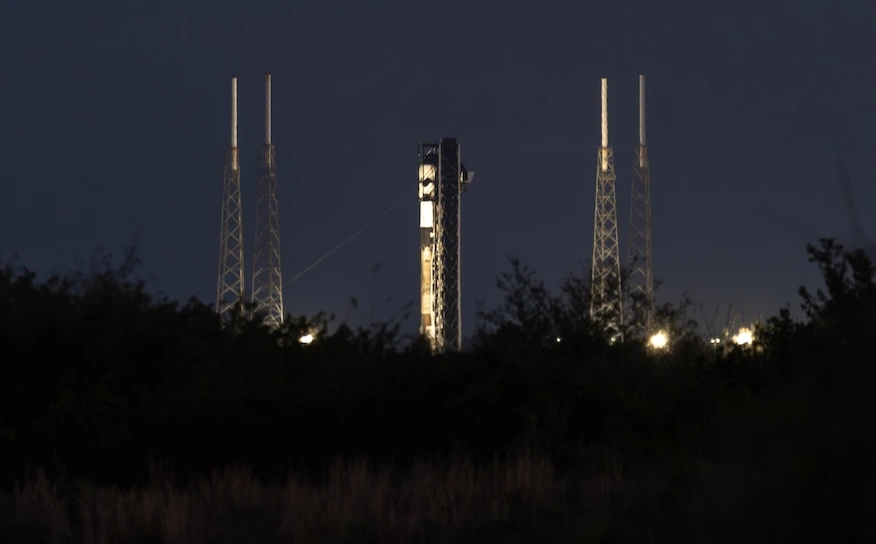
Starlink Satellites Break New Ground with 6-74 Mission

Space exploration today is not just about reaching distant planets — it’s about connecting every corner of our own world. SpaceX, through its Starlink project, continues to make this dream a reality. With each launch of Starlink satellites, humanity moves closer to a future where high-speed internet is accessible anywhere on Earth.
Key Highlights
- Successful Launch: SpaceX launched the Starlink 6-74 mission on April 24, 2025, at 9:52 p.m. ET from Cape Canaveral Space Force Station, deploying 28 Starlink satellites.
- Booster Reusability Milestone: The Falcon 9 booster B1069 completed its 23rd successful flight, landing on the droneship A Shortfall of Gravitas.
- Expanding Global Connectivity: Each launch of Starlink satellites expands high-speed internet access to remote, underserved, and disaster-affected regions.
- Future Vision: Starlink’s growing satellite constellation is paving the way for not only global internet coverage but also future interplanetary communication.
- Impact on Society: Starlink satellites empower education, healthcare, business, and disaster recovery efforts worldwide by eliminating the limitations of traditional infrastructure.
You can also read our recent articles on Bezos’ Slate EV Revolution, Bitcoin Stays Strong Amid Tariff, Tariff, Trade War and Recession, Nvidia AI Powerhouse, DeepSeek’s AI Power, China’s AI shocks the Tech World and LinkedIn Games
Starlink 6-74 Mission: Another Leap Forward
On April 24, 2025, SpaceX successfully launched another batch of Starlink satellites from Cape Canaveral Space Force Station. The Falcon 9 rocket lifted off at 9:52 p.m. ET, carrying 28 Starlink satellites stacked neatly inside its protective fairing.
This mission, designated Starlink 6-74, marked SpaceX’s 47th Falcon 9 launch of the year and the company’s 30th Starlink mission of 2025. Each successful launch reinforces the company’s commitment to building a truly global internet network that transcends borders, terrains, and traditional infrastructure.
Falcon 9 and Booster B1069: Setting New Standards

The launch also celebrated another impressive milestone in reusable rocket technology. The Falcon 9 booster, tail number B1069, executed its 23rd flight. Continuing SpaceX’s vision of reducing the cost of access to space. About two and a half minutes after launch, the booster separated from the upper stage and began its descent back to Earth.
Six minutes later, B1069 performed a flawless landing on the droneship A Shortfall of Gravitas, stationed in the Atlantic Ocean. This successful recovery not only extends the life of the booster but also demonstrates the efficiency and reliability of SpaceX’s reusable fleet.
Through reusability, SpaceX is not just saving resources; it is fundamentally changing the economics of space travel and satellite deployment. Thanks to these technological advancements, the vision of global internet connectivity is becoming more affordable and achievable.
Starlink Satellites: Bridging the Digital Divide
The real story, however, lies beyond the rockets and their engineering marvels. Each batch of Starlink satellites launched into low Earth orbit represents a profound shift in how humanity connects.
Unlike traditional internet services that depend on extensive ground-based infrastructure, Starlink satellites operate in a constellation across the sky. Users simply need a receiver and an open view of the sky to connect — no cables, no limitations, no boundaries.
For remote villages, disaster-hit regions, nomadic communities, and even scientific expeditions, this network brings opportunities that were once unimaginable. Students in isolated areas can now attend online classes. Healthcare workers can deliver telemedicine services to distant communities. Entrepreneurs in rural locations can build businesses with the same access as someone in a major city.
Every Starlink satellite launched narrows the digital divide, empowering people with tools to learn, heal, and grow — no matter where they are.
A Vision for the Future
Beyond providing internet, Starlink satellites have broader implications for global development and resilience. In times of crisis, when earthquakes, hurricanes, or conflicts destroy traditional infrastructure, Starlink’s low-orbit network can rapidly restore communication.
Moreover, as humanity sets its sights on exploring the Moon, Mars, and beyond, networks like Starlink will be essential for maintaining connections across vast distances. Today’s Starlink constellation is not only an achievement for Earth but a critical stepping stone toward future interplanetary communication systems.
SpaceX’s bold efforts show that building the future doesn’t always mean inventing something entirely new. Sometimes, it means reimagining how we use technology we already understand — and deploying it at a scale and speed the world has never seen before.
The Road Ahead: Scaling New Heights

With over 7,000 Starlink satellites already in orbit, SpaceX continues to expand its network rapidly. Yet, this is just the beginning. The company plans to deploy tens of thousands more satellites in the coming years, providing faster, more reliable, and more widespread coverage.
Advances in satellite design, such as laser interlinks that allow satellites to communicate with each other directly, will further enhance Starlink’s capabilities. Eventually, internet traffic will not only bounce between ground stations and satellites but also travel seamlessly across the sky — faster and with fewer interruptions.
As technology evolves, so too will the ways Starlink satellites can benefit humanity. From environmental monitoring and scientific research to emergency services and education, the network’s potential applications are as vast as space itself.
Starlink Satellites: Lighting Up the Sky with Hope
Each Falcon 9 launch that sends another group of Starlink satellites into orbit is more than a technical feat. It’s a symbol of what human imagination, determination, and collaboration can achieve.
In just a few short years, Starlink has gone from a daring idea to a transformative global network. It reminds us that innovation doesn’t have to be exclusive — it can be inclusive, offering opportunity to people everywhere, no matter their circumstances.
The future isn’t just arriving. It’s being built, launch by launch, satellite by satellite. And with Starlink leading the charge, a truly connected, empowered, and inspired global community is closer than ever before.
As we look up and spot those tiny moving lights across the night sky, we can feel a renewed sense of wonder — and the comforting knowledge that the world, and perhaps someday even the stars, are within our reach.
Conclusion
The launch of the Starlink 6-74 mission is more than just another milestone for SpaceX — it’s a bold step toward a future where internet access is no longer a privilege, but a universal right. With every batch of Starlink satellites reaching orbit, the vision of a truly connected world comes into sharper focus.
SpaceX is not only rewriting the rules of space exploration but also reshaping life on Earth. By bridging the digital divide, empowering communities, and inspiring innovation across industries, the Starlink satellites stand as beacons of possibility.
As technology continues to evolve, and as more satellites light up the sky, one thing is clear: the future of global connectivity is not a distant dream — it’s unfolding right now, launch by launch, connection by connection. And it’s only just beginning
FAQ – Starlink Satellites and the April 24, 2025 Launch
1. What was the purpose of the April 24, 2025 Starlink launch?
The mission aimed to deploy 28 new Starlink satellites into low Earth orbit to expand SpaceX’s global internet network.
2. Where did the launch take place?
The launch occurred at Cape Canaveral Space Force Station in Florida, from Launch Complex 40 (LC-40).
3. What time did the rocket launch?
The Falcon 9 rocket lifted off at 9:52 p.m. Eastern Time (ET).
4. Was the rocket booster reused?
Yes. The booster B1069 completed its 23rd mission and successfully landed on the droneship A Shortfall of Gravitas in the Atlantic Ocean.
5. How many Starlink satellites are currently in orbit?
As of this launch, there are over 7,000 Starlink satellites in orbit, and the number continues to grow with each new mission.
